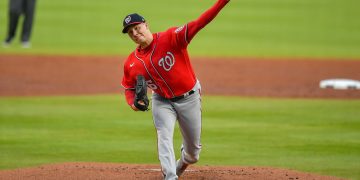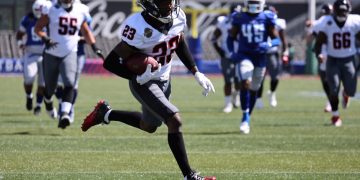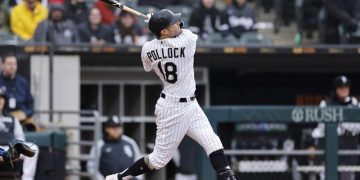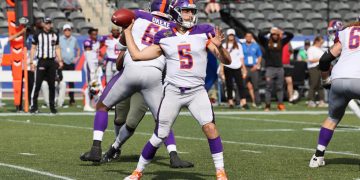In sports betting, a moneyline bet is where bettors can bet on teams to win a game. Imagine you wanted to bet on the Chicago Bears to beat the Miami Dolphins. To do so, you’d simply take the moneyline odds for the Bears, thus betting on them to emerge victorious.
Amongst US sports bettors, the moneyline is one of the most common betting markets and accounts for lots of the only taken by sportsbooks on the NFL, MLB, NHL, NBA, as well as College Sports.
Below, we’re going to delve a little deeper and cover everything there is to know about moneyline betting.
What is a Moneyline Bet?
Arguably the easiest to understand of all the bets, a moneyline bet is where a bettor chooses one team to beat another team.
For example, betting on the LA Clippers to beat the Sacramento Kings would be a moneyline bet. Similarly, if you were to bet on the San Diego Padres to beat the Los Angeles Dodgers, you’d be placing a moneyline bet.
So, in sports betting, a moneyline bet is merely a wager on a sports team to win a game. Moneyline bets are placed mostly on NFL, MLB, NHL, and NBA games, but they’re also popular among bettors focusing on college sports such as NCAA Football.
Understanding Moneyline Bets
The main thing to know about moneyline betting is that you’re betting on winners. In a game between two teams, whether it be basketball, baseball, or ice hockey, you’re betting on one team to win. As a result, by default, you’re betting on the other team to lose.
Favorites & Underdogs
If you’re intent on placing moneyline bets, then you’ll need to know how to spot the favorite and the underdog, which once you know how to, is simple enough.
Here’s an NBA fixture between the LA Lakers and the Golden State Warriors.
The moneyline odds are on the left, highlighted by the red circle. From these odds, we can see that the Warriors are the moneyline favorites. This means they’re the team that is considered to be more likely to win. Why? because they have lower odds. Whichever team has the lowest odds is the favorite. Reversely, the team with the highest odds is the moneyline underdog.
In almost every game, there will be a favorite and an underdog. Some moneyline favorites will be stronger than others, for example, if the game is considered to be a mismatch, then one team will be heavily favored in the betting.
Take this NHL clash between the Arizona Coyotes and the Pittsburgh Penguins for example:
Here we can see that the Penguins are big moneyline favorites, and as such, there’s a very noticeable disparity in the moneyline odds. By the same notion, the Coyotes are big underdogs.
On the flip side, you’ll have games where the favorite isn’t very strong. In other words, their perceived advantage is minimal. Let’s look at the odds for the NBA game between the Washington Wizards and the Indiana Pacers.
We can see that the Wizards are favorites, but not big ones. This means that the Pacers are not big underdogs either. With odds like this, it wouldn’t be the greatest surprise if the Pacers won the game, as the difference between the two, according to the moneyline odds, isn’t that great.
Pick’Em
On rare occasions, there will be no noticeable favorite and no obvious underdog. There is a name for such an occurrence.
In moneyline betting, the term “pick’em” refers to games where there isn’t a favorite. This is rare, as usually, one team will be preferred by the sportsbook when they release the moneyline odds.
It’s not entirely unheard of for teams to be evenly matched in the betting. See below in the Moneyline & Sports section for an NHL game where the teams were very evenly matched. This could be referred to as a pick’em game.
Implied Probability
It’s important to remember that betting odds are just an expression of probability. When a sportsbook lays moneyline odds, that’s just the sportsbook saying that they believe each team has a certain chance of winning.
Before we get into implied probability, though, let’s first go over the fact that we have negative odds, and positive odds.
To keep things simple, if the odds have a “+”, then they’re positive odds. If the odds have “-“, then they’re negative odds. So, for example, +100, +165, +400, are all examples of positive odds. Negative odds are -110, -150, -200, and so on.
Now, let’s move on to implied probability, which lies behind both positive and negative odds.
Once you understand the implied probability behind moneyline odds, then you can start to form your own odds based on your own knowledge/research of the teams in question. You can then start to gain an edge.
For example, if the LA Lakers are priced at +100 on the moneyline, this translates as 50% implied probability. The moneyline odds are just a reflection of implied probability. In other words, when the odds are first released, they simply show how likely something is to occur, according to the sportsbooks opinion.
Nowadays, in the age of information being widely available online, the bettor can use probability calculators to find out the implied probability of moneyline bets.
Moneyline & Sports
On which sports can you place a wager on the moneyline? The answer is most of them, at least most of the big US team sports.
NFL
Moneyline betting is hugely popular in the NFL. Some bettors love to bet on the favorites, and see doing so as a shortcut to riches, while others like to try and identify games where the underdogs can cause an upset.
Sometimes, NFL teams will be evenly matched, and thus the moneyline odds will be close. Here’s an example of an NFL encounter where both teams were rated as having similar chances on the moneyline. In other words, a “pick’em”.
NBA
As a team sport with a winner and a loser, NBA is naturally suited to moneyline betting. When it comes to online sports betting in the US, NBA moneyline bets are hugely popular.
MLB
The Moneyline is also popular a betting market among Major League Baseball fans. On the moneyline, you can wager on teams to win individual games, as well as wager on teams to win the series, such as below:
NHL
Again, with NHL games producing a winner and a loser, moneyline betting is popular. Home teams are often expected to prevail, which is why in this example, the WAS Capitals are the favorites when hosting the BOS Bruins.
MLS
When it comes to soccer, for example, Major League Soccer, things obviously are a little different. Why? Because in soccer, there are three possible outcomes. This means that you can also bet on a tie as well on either team to win.
The moneyline market can also be referred to as ‘1X2’ in soccer. The “1” represents the home team. The “2” represents the away team, and the “X” represents the tie.
Here’s some example odds for an MLS game between the New York Red Bulls and FC Cincinnati:
Moneyline Betting Outcomes
When you place a money line bet, you generally have two options, that’s it. You can bet on Team A to win, or you can bet on Team B to win. It’s as easy as that.
All moneyline bettors are focused on is the winner of the fixture. For example, if you’re betting on the NFL, the MLB, the NBA or the NHL, then you can either bet on the home team or the away team to win.
However, if you’re betting on soccer, things are a little different. There are three options. This is of course because the match can end in a tie. So on the soccer moneyline, you can bet on Team A to win, Team B to win, or you can bet on the tie.
As mentioned above, in soccer, there’s also an extra moneyline-type market known as ‘Draw No Bet’. Here you can bet on Team A to win, or Team B to win. If your chosen team wins, you’ll win the bet, but if the match ends in a tie, you’ll get your stake back as a refund. The drawback is that you’ll accept lower odds on ‘Draw No Bet’ wagers, but the potential refund is of course an upside.
‘Draw No Bet’ is a great option if you like the chances of an outsider ahead of a soccer match. You don’t necessarily think that they’re destined to win, but you think they’ve got a good chance of upsetting the odds so you take them on the ‘Draw No Bet’ line knowing that you’ll get a refund if the game ends all square.
Understanding Moneyline Odds
It’s also necessary to understand that moneyline odds change. Once a sportsbook releases its odds, what bettors do reflects what happens with the odds. This means that the weight of money moves the odds.
Let’s say for example that the New England Patriots open on the moneyline at -110, but lots of bettors take those odds, then the price shortens to -150. Similarly, if the New England Patriots weren’t being bet on, the odds could increase, say from -110 to +110. Think of it as supply and demand. The more demand there is for a bet, the shorter the odds become.
The moneyline can and often will continue to change right up until the game starts.
How do Sportsbooks Make Money?
Sportsbooks earn their money by applying something known as vigorish, otherwise known as vig or juice. The sportsbook will apply a certain amount of vig to ensure that they make a profit.
Implied probability plays a big part here. The implied probability should add up to 100%, but sportsbooks make their money by pricing up in a way that adds up to greater than 100%, the surplus percentage being the vig.
Let’s take a look at an example.
If we’re looking at an NFL game for instance, when we translate the moneyline odds into probabilities we should arrive at a combined probability of 100%. This is because there are only two outcomes. Team A wins, or Team B wins. The probability of either team winning should add up to 100%.
Example odds:
Team A = -125 (55.56%)
Team B = +125 (44.44%)
The implied probabilities here add up to exactly 100%.
However, the sportsbook will have it so that the odds add up to greater than 100%. Like this:
Team A = -125 (55.56%)
Team B – +105 (48.78%)
The implied probabilities here add up to 104.34%. The extra 4.34% is the sportsbook vig.
Pricing the moneyline in this way gives the sportsbook a mathematical edge. The idea is that they’ve built in the advantage to ensure a profit is arrived at regardless of the outcome.
Canceled Moneyline Bets
There are instances where moneyline wagers can be refunded, though it’s important to check the specific rules of your chosen sportsbook, as some sportsbooks behave differently to others in this regard.
If a game is not completed or is canceled entirely, say because of inappropriate weather conditions, then most sportsbooks will refund bets on the moneyline.
It’s always a good idea to check the terms of your chosen sportsbook before playing, just so you know exactly what to expect in such circumstances.
Moneyline FAQs
How do moneyline bets work?
Moneyline betting is simple. All you need to do is choose a team to win. On the moneyline, you bet on your chosen team to win the game.
Are Moneyline bets good bets?
This depends. Moneyline bets can be good bets if you know what you’re doing. If you have lots of knowledge of the teams involved, and plenty of info on the game you’re betting on, and you’re making an informed betting decision, placing a bet at odds that you believe to be in your favor, then yes, betting on the moneyline can be great.
Does Moneyline mean win or lose?
Betting on a team on the moneyline means that you’re betting on that team to win. You’re also betting on the other team to lose.
What is a good moneyline bet?
A good moneyline bet is one that is carefully thought out. For example, if you’ve done your research and discovered early on that some of Team A’s key players won’t be playing, then a bet on Team B to win on the moneyline could be a good bet.
Essentially, good moneyline wagers are ones that are placed after careful consideration. When a bettor takes into consideration a plethora of factors and arrives at an informed decision, then they will usually lock in a good moneyline bet.
Should you bet on the MoneyLine?
If you’re looking to bet on teams to win, then absolutely. For example, if you want to bet on the Denver Nuggets to beat the Utah Jazz, then a moneyline wager is for you.
What about Moneyline Bet Parlays?
Many sports bettors like to combine several wagers on the moneyline. They do this to make one larger bet. This is called a multiple or a parlay.
For example, if you want to bet on the Baltimore Ravens, the Cincinnati Bengals, and the Jacksonville Jaguars all to win, then you’d do so by placing a moneyline parlay.
Is Moneyline betting different to Point Spread betting?
Yes. Moneyline betting is different to point spread betting. Moneyline bettors only need to bet on the winning team to win their bet.
In contrast, point spread bettors can lose even if their chosen team wins. This is because they didn’t cover the spread. Point spread bets involve betting on teams to win or lose based on a head start. For example, you could bet on the New York Giants +3.0, which means that for you to win your bet, the Giants would simply need to win the game or lose by two points or less.






